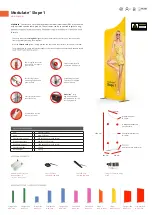
36
User's Guide HDSP System Multiface II
© RME
21. Disconnect Mode
RME's exclusive Disconnect mode lets you adjust level, input selection and signal mix via your
computer, and simply detach the Multiface afterwards. With this, a stand-alone operation of the
Multiface gets possible. When the Multiface has been configured using Settings dialog and To-
talMix, it won't loose those settings after detaching it from the computer if an external power
supply is used, because the Multiface (as all HDSP I/O-boxes) does not contain memory, so all
settings get lost upon power-off.
If you do not need to record or playback audio with your computer, the Multiface can be used in
a fixed configuration, for example as:
•
8-channel analog/ADAT/analog converter with monitoring
•
SPDIF AD- or DA-converter
•
Mixer / Patchbay / Distributor analog and digital
•
Headphone
mixer
•
Line splitter with balanced output
•
whatever you just need!
The unit can also stay connected to a desktop computer, receiving its power from there. The
Disconnect mode will then cause the unit to be isolated from the computer, no longer be avail-
able to any software or other changes – an interesting security application.
22. Analog Connections
22.1 Line Inputs
The Multiface has eight balanced Line inputs as 1/4" TRS jacks on the back of the unit. The
electronic input stage is built in a servo balanced design which handles unbalanced (mono
jacks) and balanced (stereo jacks) correctly, automatically adjusting the level reference.
When using unbalanced cables with TRS jacks: be sure to connect the 'ring' contact of the
TRS jack with ground. Otherwise noise may occur, caused by the unconnected negative
input of the balanced input.
One of the main issues when working with an AD-converter is to maintain the full dynamic
range within the best operating level. Therefore the Multiface II internally uses hi-quality elec-
tronic switches, which allow for a perfect adaptation of all eight inputs to the three most often
used studio levels. The configuration is done with the front panel switch ANALOG LEVEL
INPUTS.
The 'standardized' studio levels do not result in a (often desired) full scale level, but take some
additional digital headroom into consideration. The amount of headroom is different in different
standards, and again differently implemented by different manufacturers. Because of this we
decided to define the levels of the Multiface in the most compatible way.
Reference
0 dBFS @
Headroom
Lo Gain
+19 dBu
15 dB
+4 dBu
+13 dBu
9 dB
-10 dBV
+2 dBV
12 dB
With +4 dBu selected, the according headroom meets the latest EBU recommendations for
Broadcast usage. At -10 dBV a headroom of 12 dB is common practice, each mixing desk op-
erating at -10 dBV is able to send and receive much higher levels. Lo Gain is best suited for
professional users who prefer to work balanced and at highest levels. Lo Gain provides 15 dB
headroom at +4 dBu nominal level.
Summary of Contents for DSP Multiface
Page 5: ...User s Guide HDSP System Multiface II RME 5 User s Guide Multiface II General...
Page 42: ...42 User s Guide HDSP System Multiface II RME...
Page 43: ...User s Guide HDSP System Multiface II RME 43 User s Guide Multiface II TotalMix...
Page 45: ...User s Guide HDSP System Multiface II RME 45...
Page 67: ...User s Guide HDSP System Multiface II RME 67 User s Guide Multiface II Technical Reference...
Page 74: ...74 User s Guide HDSP System Multiface II RME 31 Diagrams 31 1 Block Diagram Multiface II...
Page 76: ...76 User s Guide HDSP System Multiface II RME...
Page 77: ...User s Guide HDSP System Multiface II RME 77 User s Guide Multiface II Miscellaneous...
















































